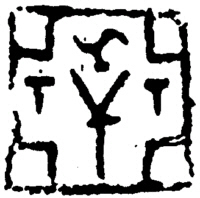Chapter 2 Section 1 The Origin of Seal Art
In 1973, at the excavation site of the Mawangdui Han Tomb in Changsha, Hunan Province, after opening the tomb that had been closed for more than 2,000 years, archaeologists saw rows of bamboo 笥〔si四〕 (square bamboo ware woven with bamboo mites) neatly stacked on both sides of the coffin. ), each bamboo is wrapped and tied with ropes, and wrapped with green mud balls at the places where the ties are tied. Remains of the ancient use of seals.
The history of the use of seals in China can be traced back to the Shang Dynasty more than 3,000 years ago (about the beginning of the 17th century BC to the 11th century BC) from the archaeological remains. A seal was unearthed from the tomb site of the Shang Dynasty in Anyang, Henan. The seal surface is four corners The adjoining square is called sub-glyph, and the inscription is the image of a bird.Accompanied by a model for casting bronze wares, it can be seen that this seal is a mold for making bronze decorations.In terms of function, it is different from the seals of later generations, but it reveals that the appearance of the seal was deeply influenced by Qi Ke.As far back as the Neolithic Age Dawenkou Culture (4300 BC-2500 BC) pottery inscriptions were found on the pottery; divination events were recorded on oracle bones in the Yin and Shang Dynasties, and inscriptions were also inscribed on the oracle bones; when casting bronzes, people Combining the engraving technique with metal casting, bronze inscriptions with historical value are created.This shows that the production of seals is inherited from the tradition of engraving.The use of seals also retains the characteristics of the Neolithic pottery making process. The decorations on the Neolithic pottery, such as geometric patterns, are printed on the pottery surface with pottery pads with carved patterns.In the site of the Shang Dynasty in Liujiahe, Beijing, a pottery mold was unearthed (the excavation report called pottery clap), which is very similar in shape to a seal. seal.The difference is that the stamp is thinner than the seal, and the handle is larger than the stamp, which is a thin sheet carved with hollow patterns.
In 1992, the famous archaeologist Li Xueqin wrote the article "The Origin of Chinese Seals", discussing that the three bronze seals collected by the National Palace Museum in Taiwan are the seals of the Shang Dynasty, thus providing the earliest physical examples of the origin of Chinese seals.These three copper seals were unearthed in the Yin Ruins of Anyang, Henan in the late 1930s.The three seals are similar in shape, all of which are flat plate-shaped prints, square prints, casting Yangwen and nose buttons.Because it was unearthed without scientific excavation, it was circulated repeatedly, and many scholars have questioned its age and authenticity.Li Wen started by interpreting the seals, compared with the bronze inscriptions, and determined that two of the bronze seals were the names of clans in the late Shang Dynasty.Confirmed as an ancient seal from the late Shang Dynasty.He also pointed out that the production of these three seals is relatively mature, and their origins can still be traced back.
The pottery stamps and bronze seals of the Shang Dynasty are related to pottery pai in terms of shape.Seals with the function of engraving inscriptions were formed around the Spring and Autumn Period of the Western Zhou Dynasty. "Zhou Li Qiu Guan Zhi Jin" contains: "Those who are recruited by them will distinguish the beauty and evil of their objects and their quantity, and seal them." , so that Gongye asked, and the seal letter was chased and given to him.” The Western Zhou Dynasty implemented a patriarchal feudal system, and the central royal family and vassal states issued decrees, and all entrusted to handle military and state affairs required certificates of power.Private economic and civil activities also require contractual proof.Seals play a role in social life as a token of credibility of political institutions or personal power.The above documents reflect that the use of seals in the Spring and Autumn Period of the Western Zhou Dynasty was very similar to that in the Qin and Han Dynasties of the Warring States Period.However, no actual seals from this period have been found.
A large number of seal remains from the Warring States period indicate that seals were very popular during the Warring States period, and the use of seals became a popular fashion, forming the first development climax of Chinese seals.
Chinese characters have gone through several stages of evolution, including oracle bone inscriptions, bronze inscriptions, seal script, official script, and regular script.The era of universal seal script coincided with the climax of seal development. In addition, seal script fonts were suitable for engraving [juan donated], and the seal script of later generations was still printed with seal script, so that a printing tradition based on seal script was formed. Therefore, the art of seal is also known as the art of seal cutting. say.

Shang "Yaro Shi" seal

Shang "wing" seal

Shang "Yaro Shi" seal

Shang "wing" seal
